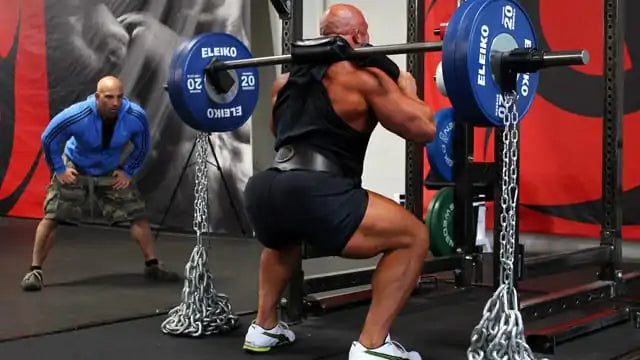
Breaking Plateaus with Accommodating Resistance: A Guide to Bands and Chains
Have your lifts stalled? Do you find that you're strong off the floor or out of the hole, but fail at lockout? If so, it might be time to introduce one of the most powerful tools in strength training: accommodating resistance. Made famous by Louie Simmons and the legendary Westside Barbell, training with bands and chains isn't just for show—it's a scientifically-backed method to build explosive strength and smash through sticking points. This guide will teach you the what, why, and how of using bands and chains in your powerlifting program.

What is Accommodating Resistance?
Accommodating resistance is a training method where the load changes throughout the range of motion. By adding bands or chains to the barbell, the weight is lightest at the bottom of the lift (where you are biomechanically weakest) and progressively heavier towards the top (where you are strongest).
The primary purpose is to match the resistance curve of the exercise with your natural strength curve. This forces you to accelerate through the entire lift, teaching your body to generate maximum force and speed from start to finish.
Training with Chains
Chains are the classic tool for accommodating resistance. As you lift the bar, more links come off the floor, increasing the weight. As you lower the bar, more links pile up, decreasing the weight.
-
How They Work: Chains teach you to handle heavier weights at lockout and improve stability. They provide a dynamic, slightly unstable load that forces your stabilizing muscles to work harder.
-
Key Benefits:
-
Overloads the Lockout: You get the benefit of handling near-maximal weight at the top without being crushed by it at the bottom.
-
Teaches Acceleration: To complete the lift, you must learn to drive through the increasing resistance with explosive force.
-
-
How to Set Up Chains: Drape the chains over the sleeves of the barbell so that a significant portion (or all) of the chain is on the floor at the bottom of the lift. As you stand up, the links should lift off the floor smoothly. For a deep dive into setup, resources from experts at EliteFTS are invaluable.
Training with Bands
Bands provide a different kind of accommodating resistance called "overspeed eccentrics."
-
How They Work: As you lower the bar, the stretched bands actively pull you down faster than gravity alone. This forces you to absorb more kinetic energy and then violently reverse the motion.
-
Key Benefits:
-
Builds Explosive Strength: The overspeed eccentric phase supercharges the stretch reflex, teaching you to be incredibly explosive out of the bottom position.
-
Increases Rate of Force Development (RFD): You learn to generate force very, very quickly.
-
-
How to Set Up Bands: Bands should be anchored securely to the bottom of a power rack or with heavy dumbbells. Loop them evenly over the sleeves of the barbell. The tension should be significant at the top of the lift but still present at the bottom.
How to Program Accommodating Resistance
Bands and chains are most commonly used in two ways, often within a Conjugate-style program:
-
Dynamic Effort (DE) Days: This is the most common application. The goal is speed.
-
Formula: Use a submaximal bar weight (e.g., 50-60% of your 1RM) plus a percentage of band or chain resistance (e.g., 25%).
-
Example (Bench Press): For a 150kg bencher, this might be 75kg of bar weight plus 30-40kg of band tension at the top.
-
Execution: Perform many sets of low reps (e.g., 8-10 sets of 2-3 reps), focusing on moving the bar as fast as humanly possible.
-
-
Max Effort (ME) Days:
-
Formula: Use bands or chains with your max effort exercise variation to overload the lockout and attack specific weaknesses.
-
Example (Squat): Work up to a 1-rep max Box Squat against heavy chains.
-
Accommodating resistance is an advanced technique, but when applied correctly, it can be a game-changer for breaking through plateaus. By forcing you to accelerate through the entire lift and overloading the lockout, bands and chains build a new level of speed and power that translates directly to a bigger raw total. Start light, master the setup, and get ready to become more explosive.
Have you ever trained with bands or chains? Share your experience in the comments below!








